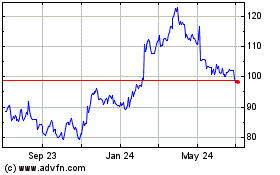Disney Has History of Leadership Battles
April 05 2016 - 3:30PM
Dow Jones News
By Rachel Emma Silverman
For Walt Disney Co., power plays are nothing new.
The media conglomerate has had a history of leadership fights
and succession struggles befitting a plot of the fairy tales
associated with the company.
In the latest twist, on Monday the company's succession planning
was thrown into turmoil when Tom Staggs, Disney's chief operating
officer and the heir apparent to Chief Executive Robert Iger,
unexpectedly announced he would step down. The news shocked many
company employees and media watchers, who assumed Mr. Staggs, a
close personal friend of Mr. Iger, would be named to succeed
him.
But behind the scenes, Disney directors concluded in recent
weeks that Mr. Staggs was unlikely to get the CEO job based on a
year of performance as chief operating officer. Now, after Mr.
Staggs' resignation, Disney's board will "broaden the scope of its
succession-planning process to identify and evaluate a robust slate
of candidates for consideration," the company said Monday.
A CEO's expected successor rarely resigns so close to the
expected transfer of power, according to succession experts. In
rising to the No. 2 slot, Mr. Staggs already had beaten out another
rival, former Chief Financial Officer Jay Rasulo, when Mr. Staggs
was appointed chief operating officer last year. In June 2015,
Disney said Mr. Rasulo would step down.
Mr. Iger was named CEO more than a decade ago, in 2005.
Before Mr. Iger's tenure, his predecessor as CEO, Michael
Eisner, was snared in a series of cinematic leadership battles. In
1994, after then-president Frank Wells died in a helicopter crash,
Disney Studio chairman Jeffrey Katzenberg abruptly resigned and
formed DreamWorks SKG because Mr. Eisner wouldn't appoint him to
the open president post. Mr. Katzenberg also sued Disney over the
terms of his contract.
Mr. Eisner instead recruited his friend, Creative Artists Agency
co-founder Michael Ovitz, to be president; Mr. Ovitz's tenure
lasted a little more than a year, although he received a rich
severance package that led to a lengthy shareholder suit.
Mr. Eisner also tangled with Roy E. Disney, the son of Disney
co-founder Roy O. Disney, in a fractious board dispute. In 2003,
Mr. Eisner didn't want the board to renominate Mr. Disney, citing a
mandatory retirement age of 72. Mr. Disney resigned from his
position as the company's vice chairman, accusing Mr. Eisner of
multiple management failures. Another board member, Stanley Gold,
also resigned and urged the board to oust Mr. Eisner.
The following year, at Disney's March shareholder's meeting,
some 45% of Disney's shareholders -- rallied by Mr. Disney and Mr.
Gold -- withheld proxies to re-elect Mr. Eisner to the board.
The company's occasional struggles at the top goes back to the
death of Walt Disney in 1966, which ushered in nearly two decades
of unsettled leadership.
The company clung fervently to his vision, preserving his office
exactly as he left it and adding few new animated features. That
left the company creatively dormant. By the 1970s, Disney was the
object of hostile takeover attempts.
It wasn't until the board recruited Mr. Eisner from Paramount
Pictures to be chairman and CEO in 1984 that the company was seen
regaining focus.
In September 2005, Mr. Eisner stepped down as the CEO of Disney,
and Mr. Iger has been at the helm ever since. Mr. Iger, 65, has
said he plans to retire in June 2018.
Whether Mr. Staggs' announced departure this week means that Mr.
Iger will stay on past his announced retirement date remains to be
seen, although Mr. Iger hasn't indicated that he plans to do
so.
--Ben Fritz, Joe Flint and Joann S. Lublin contributed to this
article.
Write to Rachel Emma Silverman at rachel.silverman@wsj.com
(END) Dow Jones Newswires
April 05, 2016 15:15 ET (19:15 GMT)
Copyright (c) 2016 Dow Jones & Company, Inc.
Walt Disney (NYSE:DIS)
Historical Stock Chart
From Aug 2024 to Sep 2024

Walt Disney (NYSE:DIS)
Historical Stock Chart
From Sep 2023 to Sep 2024
